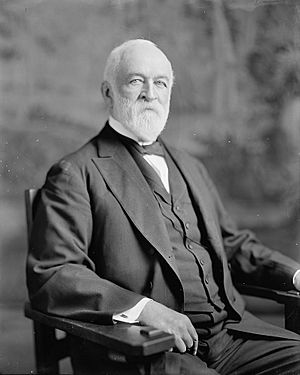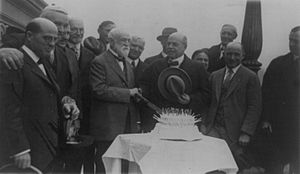Charles Manly Stedman facts for kids
Quick facts for kids
Charles M. Stedman
|
|
|---|---|
 |
|
| Member of the U.S. House of Representatives from North Carolina's 5th district |
|
| In office March 4, 1911 – September 23, 1930 |
|
| Preceded by | John M. Morehead |
| Succeeded by | Franklin W. Hancock Jr. |
| 5th Lieutenant Governor of North Carolina | |
| In office January 21, 1885 – January 17, 1889 |
|
| Governor | Alfred M. Scales |
| Preceded by | James L. Robinson |
| Succeeded by | Thomas M. Holt |
| Personal details | |
| Born |
Charles Manly Stedman
January 29, 1841 Pittsboro, North Carolina |
| Died | September 23, 1930 (aged 89) Washington, D.C. |
| Political party | Democratic |
| Spouse | Catherine Defosset Wright |
| Alma mater | University of North Carolina |
| Occupation | Lawyer |
| Military service | |
| Allegiance | |
| Branch/service | Confederate States Army |
| Years of service | 1861–1865 |
| Rank | |
| Unit | 1st (Bethel) North Carolina Infantry 44th North Carolina Infantry |
| Battles/wars | American Civil War |
Charles Manly Stedman (born January 29, 1841 – died September 23, 1930) was an important politician and lawyer from North Carolina. He served in the U.S. Congress for many years.
Contents
Early Life and Education
Charles Manly Stedman was born in Pittsboro, North Carolina. In 1853, he moved to Fayetteville, North Carolina with his family. He went to Pittsboro and Donaldson Academies. In 1861, he graduated from the University of North Carolina at Chapel Hill. He was part of the Dialectic and Philanthropic Societies there.
Service in the Civil War
During the American Civil War, Stedman joined the Confederate States Army. He started as a private in the Fayetteville Independent Light Infantry Company. This company was part of the 1st North Carolina "Bethel Regiment." Later, he was promoted to Major in the 44th North Carolina Infantry.
After the war, Stedman returned to Chatham County, North Carolina. He taught school in Pittsboro for one year. He then studied law and became a lawyer in 1865. He began his law practice in Wilmington, North Carolina.
Political Career
Stedman first became involved in politics in 1880. He was a delegate at the Democratic National Convention. This convention chose Winfield Scott Hancock for President.

Lieutenant Governor of North Carolina
In 1884, Stedman was elected the fifth Lieutenant Governor of North Carolina. He served in this role from 1885 to 1889. In 1888, he tried to become the Democratic candidate for Governor of North Carolina but was not successful.
Later Career in Law and Public Service
In 1891, Stedman moved to Asheville, North Carolina. He then moved to Greensboro, North Carolina in 1898. He continued to work as a lawyer. He also served as a trustee for the University of North Carolina from 1899 to 1915. From 1900 to 1901, he was president of the North Carolina Bar Association. He ran for Governor of North Carolina again in 1903-04 but did not win. From 1909 to 1910, he was a director and president of the North Carolina Railroad.
Serving in Congress
In 1910, Stedman was elected as a Democrat to the United States House of Representatives. He was reelected many times. He served in Congress in 1912, 1914, 1916, 1918, 1920, 1922, 1924, 1926, and 1928.
He served until his death on September 23, 1930, in Washington, D.C.. Charles M. Stedman was the last veteran of the Civil War to serve in the United States Congress. This includes veterans from both the Union and Confederate armies. He was buried in Cross Creek Cemetery in Fayetteville, North Carolina. A special sign was placed in Fayetteville to honor him.

